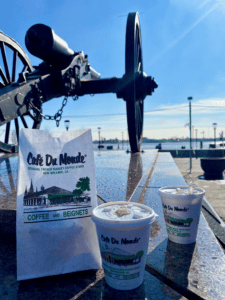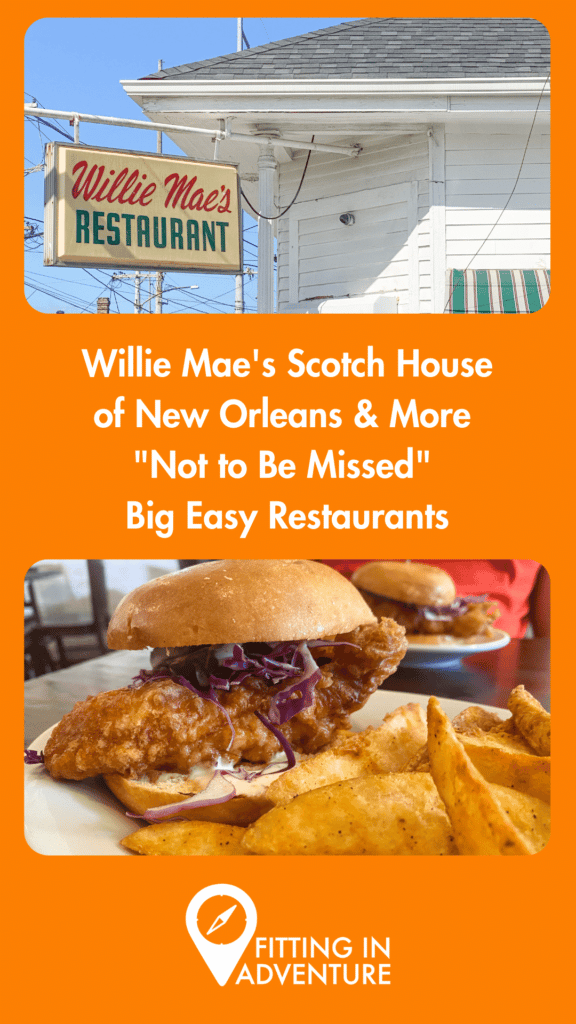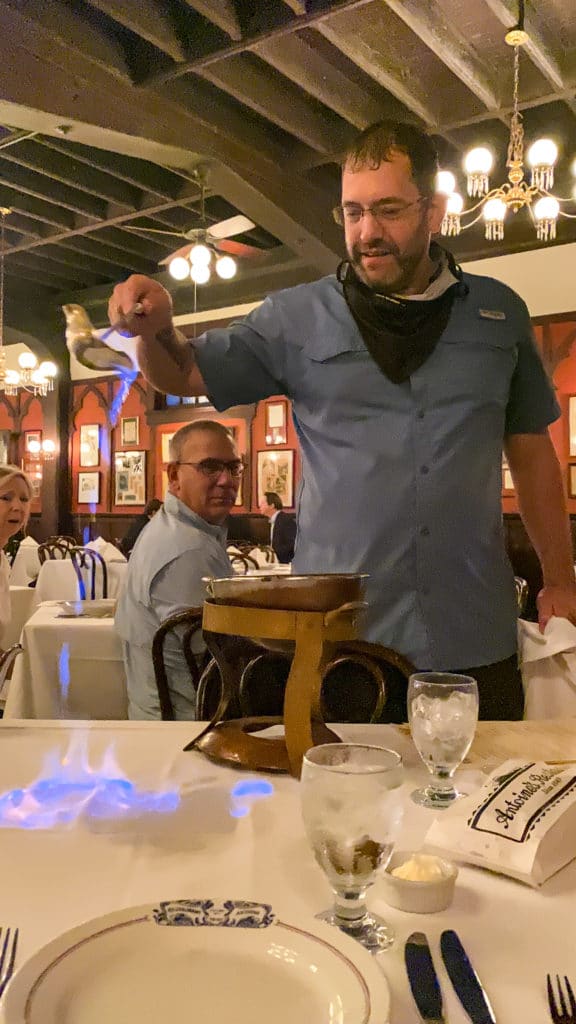If you think you are staying on a diet while visiting New Orleans, well, you are wrong. Walk the path laid out here and enjoy the time. You will need at least thirteen meals during your New Orleans visit. The food of New Orleans consists of things you may not typically like, but if you try it their way you will cave. It doesn’t make any sense, but it is true. Let’s talk about creole versus cajun first. Creole is described as the marriage of European cuisines to local Louisiana ingredients. Cajun is often described as “country food” and does not include the tomatoes that will be in Creole food.
Disclosure: Some links on our site are affiliate links. If you purchase a linked item, we will make a commission, at no extra charge to you.
You determine how many days thirteen meals will equal (no judgment), but here are the places you must-try during your visit!

Café du Monde
You’ve likely heard of this one. You will be left with a sugar high wondering how many pounds of powdered sugar they go through in a day and covered in the white powder (don’t wear black this day). The best beignets we found were here. We tried a few. (Beignets of New Orleans)
(several locations around New Orleans, but the most popular is across from Jackson Square)
Central Market (Decatur St – across from the French Market)
This third-generation old-fashioned grocery store was founded in 1906 by Salvatore Lupo. The Sicilian immigrant became notorious for creating the muffuletta. The muffuletta sandwich consists of a 9-inch round Sicilian sesame loaf. Somehow the bread remains crusty despite the fillings of ham, salami, mortadella, swiss, provolone, and their signature briny marinated olive salad of Kalamata and green olives with pickled vegetables. Each sandwich claims to serve 2-3. Yes, they are giant!
(Check their site www.centralgrocery.com for hours. The storefront received damage during Hurricane Ida and was closed on our last trip)
Domilise’s Po’Boys (Uptown)
Founded in the 1930s by Sam and Dorothy “Miss Dot” Domilise until her death in 2013, this is one of those places the locals covet as their own. The walls of the tiny restaurant are adorned with their famous customers and the grill is open for all to see. You will find a couple of random tables outside and just six inside, but any wait you have is well worth it! Featured on many food shows and named the best sandwich on the Gulf Coast for its shrimp po’boy. The accolades are enormous for this little shop, but the staff (many of which have worked here for decades) are humble and the food is made with love. It will be messy. It will be worth it.

Terrytown Cafe (Terrytown)
Home to the King Cake donuts (if they have them). People come across the bridge just for this donut run.
Willie Mae’s Scotch House (Tremé)

The most important thing to keep in mind here is Willie Mae’s Scotch House is not the same as the Willie’s Chicken shops you will see in the French Quarter. For this chicken goodness, you need to head over to Tremé. Watch the potholes and be prepared to stand on the corner waiting for your turn at one of the few tables inside. It will be worth the wait and the pothole swerves.
Established in 1957 as a simple bar. A year later in a new (and current) location, the bar had a barbershop and beauty salon in the front. Fast forward to the 1970s and the beauty salon closed to make more room for the fried chicken patrons of Willie Mae’s. Known as the “best fried chicken in America” today. While I haven’t tried them all I cannot imagine anyone getting it better than Willie Mae’s. It’s worth the Uber to the Tremé. Go. Enjoy the chicken!
Liuzza’s by the Track (Tremé)
In a po’boy obsessed city, Liuzza’s offers a hearty take on the po’boy with seafood, local sausage, 13 spices, and their “secret” ingredients. They offer a house specialty of fried eggplant dusted with powdered sugar with a marinara side. But the gumbo is what brings the majority of locals to Liuzza’s.
Antonie’s Famous Cakes & Pastries (Gretna)
Not to be confused with Antoine’s Restaurant in the French Quarter. Antoine’s Famous Cakes & Pastries is known for their King Cakes, Queen Cakes, and glazed beignets. Claiming to be home to the original Queen Cake. What is a Queen Cake? It was described as a “revved up” King Cake including apples, cream cheese, strawberry, and bavarian cream filling. The glazed beignets were the only version we found during our beignet tour of New Orleans (insert beignet link) and worth the trip across the river.
Brennan’s (Royal Street)
A tradition for visitors and locals to New Orleans since 1946. Brennan’s is home to the original Bananas Foster. New Orleans became a center for banana imports from Central and South America. This caused Owen Brennan to challenge his chef Paul Blangé to create a dish featuring bananas in 1951. The result was the dramatic flambéed Bananas Foster. Named for a friend of Owen Brennan, Richard Foster. Foster was also the chairman of the newly formed New Orleans Crime Commission.
The dish has a minimum order of two per table but is well worth the calories. If you crave the dish at home Brennan’s has released their recipe.
Brennan’s is known for their Rum Milk Punch if you are on a cocktail tour.
Casamento’s (Magazine Street)
Tucked next to a costume shop is a small unassuming restaurant. Although you may recognize it from the numerous movies it has appeared in over the years. Dating back to 1919 without many changes including the 100-year-old imported Italian tile. So much tile that it took four companies across the United States to fill Mr. Casamento’s order when he built the restaurant. Bucking the New Orleans tradition of using French bread, Casamento’s use their own signature “pan bread” for their oyster loaves. (Note: Emeril calls their oyster loaf the “Peacemaker.” He claims you can bring it home after a late night out to make your spouse happy.)
Known for their oyster loaf and oyster stew.
Antoine’s Restaurant (French Quarter)

Boasting the largest above-ground wine cellar in the United States. This fifth-generation French Quarter restaurant excels at making you feel like family as you dine with them. The kitchen was the birthplace of Oysters Rockefeller. Chef Jules Alciatore was said to invent the dish as a substitute for baked snails which were difficult to procure from France. The dish was named in honor of John D. Rockefeller (at the time one of the world’s richest men) due to the intense richness of the sauce.
While visiting be sure to order the Café Brulot Diabolique or “Devilishly Burned Coffee.” The drink was invented at Antoine’s in the late 1880s by Jules Alciatore. Yes, he was a busy inventive guy. Alciatore was said to be inspired by the French bon vivants. He witnessed them soak a sugar cube in Cognac and place it over a flame before extinguishing it in a cup of coffee. Today the “burnt coffee” is a performance! Served in a silver dish with flames pouring onto the table and devilish cups. The “show” is fun and the coffee is amazing!
Mother’s Restaurant
Small and always packed with locals and tourists waiting to enjoy the classic New Orleans home cooking. Known for their “debris po’boy” which is a combination of many sandwich fillers. The doors to this New Orleans favorite opened in 1938 by Simon and Mary (Mother) Landry. The large family worked the kitchen and during World War II the restaurant became a local hangout for the U.S. Marines due to the family’s spirit. Five of the seven Landry children joined the Marines. Francis Landry was the first woman in Louisiana to be accepted into the Corps.
Verti Marte Deli & Grocery (French Quarter)
Claiming to be the “best-kept secret in the New Orleans French Quarter” this little deli is tiny! You may need to twist your shoulders as you walk to the back to order. The shelves are packed and the menu is sparse, but you are sure to find a tasty po’boy here! The Wow is their most popular and the All that Jazz po’boy is the seafood-free variety. Since they are open 24 hours you can grab a late-night snack after leaving one of the many jazz rooms.
Dooky Chase (Tremé)
Last on this list, but should be first on your list! The restaurant quickly became a meeting place for the music, entertainment, and civil rights culture of New Orleans. By 1944, Edgar Dooky Chase Sr was ready to slow down so his son Dooky Jr took over the establishment. In 1946, Dooky Jr married Leah Lange Chase. It was through her vision that a small sandwich shop grew into a sit-down restaurant.
Leah has been awarded nearly every culinary award in existence and was known as the “Queen of Creole Cuisine” until her death in 2019. The restaurant is still family-owned and operated while serving up the traditional recipes.
I tell people all the time, you have to be in love with that pot. You have to put all your love in that pot. If you’re in a hurry, just eat your sandwich and go. Don’t even start cooking, because you can’t do anything well in a hurry. I love food. I love serving people. I love satisfying people.
Leah Chase
The restaurant is over-following with history as well. Presidents Obama and Bush both dined here. Ray Charles wrote “Early in the Morning” about Dooky Chase. It remains the must-stop for tourists, politicians, musicians, and more.
You worry too much about what goes into your mouth and not enough about what comes out of it.
Leah chase
Check out the famous Dooky Chase Creole Chicken recipe here.
What is New Orleans’ Chicory Coffee?
In a city known for indulgence, you can count on your coffee to help you out. New Orleans coffee is often made with chicory. Chicory is the root of a blue-flowered perennial plant. Cultivated since ancient Egypt, chicory has been roasted and mixed with ground coffee in France since the 19th century.
The British taxes on tea imports and the infamous tea party caused a preference for coffee and thus began America’s coffee addiction. French coffee crops would soon flow into New Orleans from the Caribbean. By 1840 the port was the second-largest importer of coffee in the United States.
Chicory root was added during the Civil War when Union naval blockades cut off the port of New Orleans. Since coffee shipments were halted, chicory was used to stretch the supply of coffee on hand. Regardless of how it started, chicory coffee is now a New Orleans tradition.
That tradition just might help a little over-indulgence that the city is known for as well. Chicory root tea was used for centuries to treat jaundice, liver enlargement, gout and rheumatism. All symptoms one might have after a night on Bourbon Street.
Download the Google Map list of New Orlean’s Best Restaurants here.

